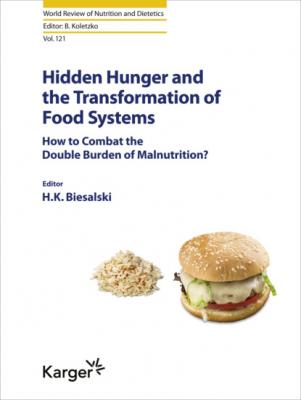Hidden Hunger and the Transformation of Food Systems. Группа авторов
Читать онлайн.| Название | Hidden Hunger and the Transformation of Food Systems |
|---|---|
| Автор произведения | Группа авторов |
| Жанр | Спорт, фитнес |
| Серия | World Review of Nutrition and Dietetics |
| Издательство | Спорт, фитнес |
| Год выпуска | 0 |
| isbn | 9783318066982 |
Targeting behavior in school-aged children and adolescents is especially important given the unique transitional periods in growth and development at this age. When children begin attending school, they are also more aware of and take some responsibility for their dietary choices and intake. During this “middle childhood” period (ages 5–9 years), not only do children begin establishing eating habits and knowledge, but also experience steady continual growth and development. Thus, it is vital that this age group is well informed, supported, and encouraged to make healthy choices. Similarly, the adolescent period (10–19 years of age) is an extremely important and rapid time of physical and psychosocial development, including puberty. This period is marked by increased nutritional needs and demands for both boys and girls; boys have higher nutrient demands due to increased bone growth and muscle mass and a faster growth rate, while girls experience growth spurts and have greater micronutrient demands, such as iron, with the onset of menstruation [27]. Special considerations should be with adolescent girls living in LMICs given the fact that 16 million girls aged 16–19 years and 2.5 million girls under the age of 16 years give birth every year. This adolescent period is also characterized by increased autonomy and a greater disposable income to purchase unhealthy food items, as well as peer pressure and social desire to fit in among social groups and body image issues that influence dietary choices and intake.
In order to address hidden hunger and optimize the diets and nutrition of children and adolescents globally, positive behavior change must be achieved. This is dependent on many factors, including people’s knowledge and understanding, perceptions, and preferences of what is healthy and unhealthy, existing eating patterns, taste preferences, appetite and levels of physical activity, and cultural norms and practices of food preparation [5]. As such, nutrition programs and interventions that target children, adolescents, and caregivers should not only provide nutrition information, education, and counselling, but also work in tandem with cultural and social norms and traditions. For example, protecting and encouraging the preservation of traditional food preparation and cooking practices, such as sprouting and soaking of seeds, can increase bioavailability of vitamins and minerals [6].
The Way Forward
Although the Sustainable Development Goals and the United Nations Decade of Action on Nutrition (2016–2025) have prioritized nutrition, greater efforts and intentionality must be made to address the growing crisis of malnutrition and hidden hunger to reach our goals in the next 5 years, especially in school-aged children and adolescents living in LMICs. The nexus between the food system and hidden hunger in this specific demographic is complex and influenced by many macro-level factors, such as national policies, effects of climate change, and conflict settings on food security and nutrition, industrialization on agriculture, and large-scale processes of food production, distribution, and marketing; as well as micro-level factors, including the personal and external food environments with which they interact, unique physiological needs, and increasing autonomy over food choice and intake.
The UNICEF Innocenti Framework clearly depicts the diverse drivers, determinants, and key components of the food system that each contribute to and affect the diets of children and adolescents, highlighting the numerous actors and subsequent entry points and ways in which the issue of hidden hunger and double burden of malnutrition can be addressed. Given its multifaceted and cross-cutting nature, synergy, collaboration, and coordination between various systems and actors are required. A holistic systems approach to nutrition with a “right to food” lens is highly recommended [2, 5, 13]. This approach involves interactions of the food system with four other global systems: health, water and sanitation, education, and social protection, and in doing so holds other systems and sectors that are able to provide nutrition interventions at scale accountable for nutrition of the global population. Ultimately, transformation of the food system through political, economic, nutrition-specific, and nutrition-sensitive actions is principal to ensuring the delivery of safe, affordable, and sustainable food worldwide, especially to the most vulnerable. Finally, it is important to consider that efforts to address hidden hunger should incorporate actions that address overweight and obesity, including physical inactivity [28], to comprehensively tackle the double burden of malnutrition in our global population.
Conflict of Interest Statement
The authors have no conflicts of interest to declare.
References
1Food Security Information Network: Global report on food crises. FSIN, 2019. http://www.fsinplatform.org/sites/default/files/resources/files/GRFC_2019-Full_Report.pdf.
2Willett W, Rockstrom J, Loken B, Springmann M, Lang T, Vermeulen S, et al: Food in the Anthropocene: the EAT-Lancet Commission on healthy diets from sustainable food systems. Lancet 2019;393:447–492.
3Afshin A, Sur PJ, Fay KA, Cornaby L, Ferrara G, Salama JS, et al: Health effects of dietary risks in 195 countries, 1990–2017: a systematic analysis for the Global Burden of Disease Study 2017. Lancet 2019;393:1958–1972.
4FAO, IFAD, UNICEF, WFP, WHO: The State of Food Security and Nutrition in the World 2019. Safeguarding against economic slowdowns and downturns. Rome, FAO, 2019. http://www.fao.org/3/ca5162en/ca5162en.pdf.
5UNICEF: The state of the world’s children 2019. Children, food and nutrition: growing well in a changing world. New York, 2019. https://data.unicef.org/resources/state-of-the-worlds-children-2019/.
6High Level Panel of Experts on Food Security and Nutrition: Nutrition and food systems. Rome, Committee on World Food Security, 2017. http://www.fao.org/cfs/cfs-hlpe/en/.
7United Nations System Standing Committee on Nutrition: Advancing equity, equality and non-discrimination in food systems: pathways to reform. Rome, UNSCN, 2018. https://www.unscn.org/en/Unscn-news?idnews=1838.
